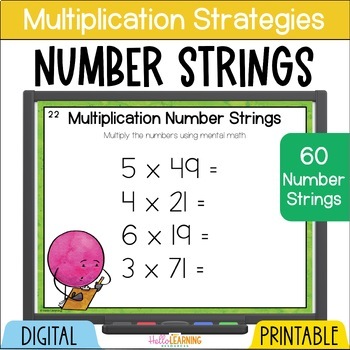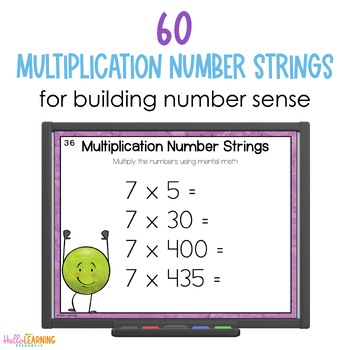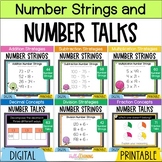Number Talks - Number Strings for Multiplication Strategies and Number Sense
- PDF
- Google Apps™

What educators are saying
Also included in
- This set of number strings gives you over 200 different number talks using the four operations to use for your math talks and daily math warm ups. Build mental math strategies and number sense with these easy to use number talks.Click the PREVIEW button to see examples of they different types of numPrice $13.97Original Price $17.00Save $3.03
- This number talks and number strings bundle includes over 300 number talks that can be used as a whole class or in small groups. Strengthen number sense and math strategies when you use these math talks as a part of math warm ups or in small group math activities.You will save 20% off the individualPrice $19.97Original Price $26.00Save $6.03
Description
This number talks resource includes 60 different multiplication number strings to use during your daily number sense activities. Different multiplication strategies are used in these number strings to strengthen your students mental math skills.
Click the PREVIEW button to see more details of what is included.
⭐ Includes both pdf and digital (Google Slides) versions.
- Link to the Google Slides ™ version can be found in the pdf file.
Multiplication problems with a variety of difficulty are included, making the math talks accessible to all students.
What's Included?
- 60 multiplication number strings
- answer key
- pdf printable version
- digital version for Google Slides ™
Multiplication strategies focused on include:
- Repeated addition
- Making landmark or friendly numbers
- Partial products
- Doubling and halving
- Breaking factors into smaller factors
- Associative property of multiplication
This number talk resource gives you a quick and easy way to help your students apply the eight common core state standards for mathematical practice.
Doing a number talk at the beginning of your math class takes only 5-10 minutes!
Number talks provide great practice in:
- mental math
- communicating results
- considering and trying other strategies
- building a collection of a variety of strategies
- making decisions to choose the most efficient strategy
- clarifying thinking
- investigating and applying mathematical relationships
- learning from mistakes
- fostering community and the value of the contributions of others
This set of number strings will provide your students practice with the multiplication strategies they need to be successful mathematicians!
Check out these other number talk resources in my store:
Number Talks - Addition - Upper Elementary
Number Talks - Subtraction - Upper Elementary
Number Talks - Division - Upper Elementary
Number Talks Bundle- All 4 Operations - Upper Elementary
Follow me and be notified when new products are added to my store.
New products are always 50% off for the first 24 hours they are posted!
Thanks!
- Dawn







